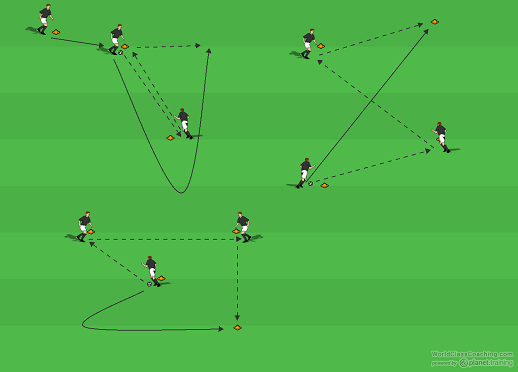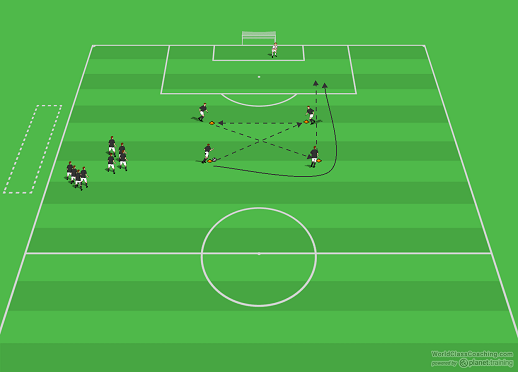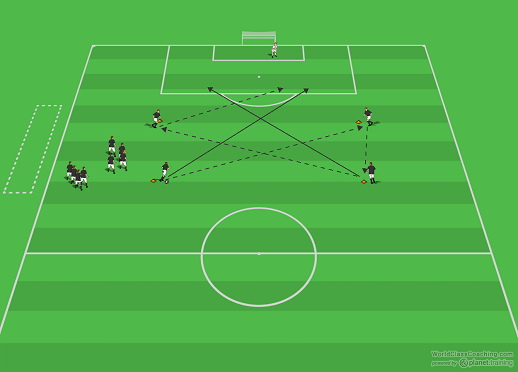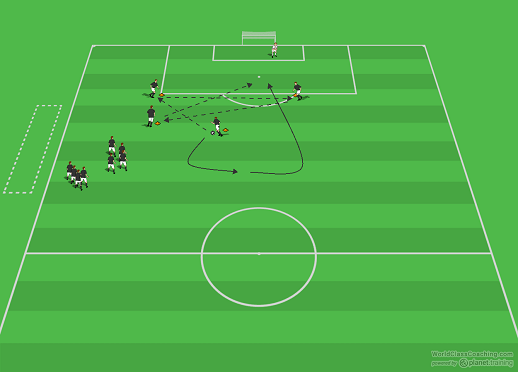By Mike Smith
One of the first things I remember a coach telling me as a youth player was “ Every run should have some shape.” I was that player who would argue a straight line is a shape. And while there are plenty of chances for the simple, straight line approach the fact is, most runs should have some shape. Shaped runs allow for the ideas of timing, deception and support to become a factor in every game; all concepts which help advance a team technically and make them more dangerous.
Lesson 1
3 Basic Shapes
Set Up
Set up these 3 stations for groups of 3-6 players. This set up can be repeated multiple times across the field based on the number of players on your team. Groups rotate between the stations every 10-15 minutes. The bottom station uses a triangle of cones spaced 12 -1 5 yds apart, with an additional drop cone no more than 20 yds back ( as shown ). The player at the point of the triangle makes a pass wide, then uses a J shaped run to support the square pass and provide a drop. The players then rotate starting positions and repeat.
Moving clockwise, the next station uses two cones, 15 – 20 yds apart on a 5 yard diagonal ( as shown ) with an additional cone marking the staging point for the player who makes the final pass. The player at the top cone passes back to the player on the bottom cone. The starting player then make a U shaped overlapping run. The player who receives the first pass sends the ball back up where the staging player comes in, receives the ball and distributes it to the overlapping player who should be finishing their run. Players rotate starting positions and repeat.
The final station uses a staggered rectangle of cones, which are placed 20 -25 yds apart ( as shown). The player at the bottom left corner starts by passing to the player to their right. This player sends the ball up and across to the player waiting at the top left of the rectangle who passes it up to the top right corner where the starting player has timed a diagonal run to receive it. Players rotate starting positions and repeat.

Coaching Points
As the players become familiar with the shape and timing of the runs these activities should become very fluid. The coach should focus on the players shaping their runs and make sure they are taking the time to make the runs in the same way they would in a game. Ask the players to visualize the ideas of delaying the attacking run, covering the square pass in case it gets picked off, or pulling a defender out of position with a bent overlap.
Lesson 2
3 Shapes to Goal
Set Up
Following are 3 diagrams which show the three shaped runs going to goal. These should be run with groups of 4, with additional groups ready to rotate in quickly. Just outside the penalty box, set up a 15 x 20 rectangle. As shown, the player at the bottom left sends a diagonal pass to the player at the top right corner. The starting player times a bent overlapping run as the remaining players work the ball to the top left corner and then to the bottom right corner. The player in the bottom right corner sends the ball up to the overlapping player who then has a shot on the keeper.

Next, widen the box for the diagonal run. Again , the player in the bottom left sends the diagonal pass to the top right corner. However, the ball is now dropped to the bottom right corner and then sent to the top left corner. Both the starting player and the player at the bottom right make diagonal crossing runs into the box AFTER the player at the bottom right sends the ball up to the top left corner. The player at the top left then picks an attacker to send the ball in to, and they have a shot on goal.

For the final progression, move the cone rectangle up to the top of the penalty box. Cover ¾ of the width of the penalty box with a 10 yd deep rectangle. The bottom right corner ( as shown ) of the rectangle is moved more centrally and dropped a bit. The player on the dropped cone starts play by sending the ball up to the top left corner. The starting player then drops their run and shadows the path of the next pass, which is square across the top of the box. The player at the top right of the cone rectangle sends it back diagonally to the bottom left corner. At the same time, the starting player turns their supporting run into an attacking run and the player at the bottom left sends the ball in for a shot on goal.

Coaching Points
All three of these stations should move quickly. The coach should make sure the players are playing at game speed and really using the shaped runs to create the desired effects; timing, delay, support and off balancing the defense.
By Mike Smith
Currently the Head Coach for University Heights Academy Boys Soccer in Hopkinsville, KY , Mike is in his 14th year as a high school head coach with 23 years coaching experience overall and 34 year as a student and fan of the game. He holds a USSF D License.


